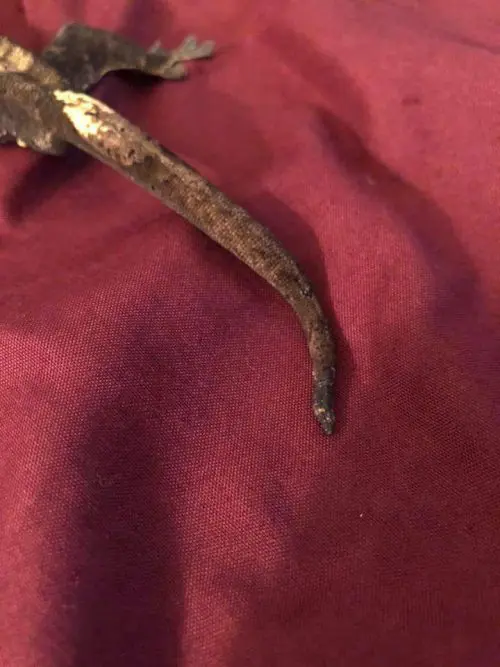Tail rot or tail necrosis is common in pet crested geckos. However, it can also have devastating consequences if you leave it untreated.
The rot can spread up the tail and result in systematic illness, which is why all crested geckos need insight into the disease, signs to look for, and the best way to treat it, ensuring that their pet reptile remains healthy in the long run.
What is Crested Gecko Tail Rot?
Tail rot in crested geckos is a very serious condition, which causes the tail to literally rot away. This is a result of an internal infection.
Eventually, the tail will fall off and the infection can spread into the body, which can cause damage to internal organs and eventually result in death.
If you suspect your crested gecko may have tail rot, you need to ensure the swift treatment to provide the best outcome for your pet.
Continue reading for signs and symptoms associated with crested gecko tail rot.
Signs and Symptoms

How tail rot in a crested gecko looks like
- Your crested gecko’s tail is blackening, starting at the tip
- The tail does not shed
- The tail feels dry to the touch with coarse skin flaking off
- Tail turns black and falls off
- Crested gecko may lose appetite
- Your friendly and calm gecko may become aggressive, it may even bite
- Your gecko starts hiding
- Signs of pain and discomfort
Causes of Tail Rot
There are a number of causes of tail rot in crested geckos starting with a bite from another gecko. Maybe the tail was pinched or crushed. Tail rot is usually a result of an infection caused by injury to the tail.
Other causes can include poor nutrition. If your crested gecko is malnourished, it will have a calcium deficiency.
Calcium is essential for cartilage growth and strong bones. This can cause the tail to become weak and prone to infection.
Another cause can be due to an incomplete shed. This can cut off the circulation to the tail.
Further tail rot can also be caused by blood clots that lodge in the tail, restricting blood flow, known as embolisms.
Not meeting the required temperatures can also cause tail rot. Hypothermia in the tail can result in infection and cause the tail to rot over time.
Treatment
It’s important to note that your crested gecko will not be able to grow its tail back once treated for tail rot. This should not impact your gecko negatively, infect crested geckos without their tails are known as “frog butts”.
The first thing you must do if you suspect your gecko has tail rot is head to your vet. The vet will be able to diagnose the tail rot and determine if the tail can be saved.
Once diagnosed, your vet will either give your gecko antibiotics to fight the infection or recommend surgery to amputate the tail.
Antibiotics
The good news is that if the vet prescribes antibiotics, you have caught the tail rot in time, and amputation isn’t required.
Ensure you keep your crested gecko hydrated while on antibiotics, this will help the kidneys process the medication a bit easier.
Surgery
The thought of your small crested gecko undergoing surgery is a scary experience, but there are times where surgery is the only way to save your reptile pet.
Surgery is offered when the tail rot has progressed and it can reduce tail loss, by removing the infection before it spreads any further.
Summary
Tail rot in crested geckos is not something that should be taken lightly or ignored. It is a serious condition that requires immediate treatment by your vet.
To ensure the best for your pet you can reduce the risk of tail rot by not housing two male crested geckos in the same enclosure, reducing the risk of fighting and injury.
Ensure you provide optimum temperatures to reduce stress and hypothermia and provide your gecko with a nutritious diet.
How can you tell if the tail is getting better? Will the dead part just fall off? Can crested geckos regrow just the tip of their tail?